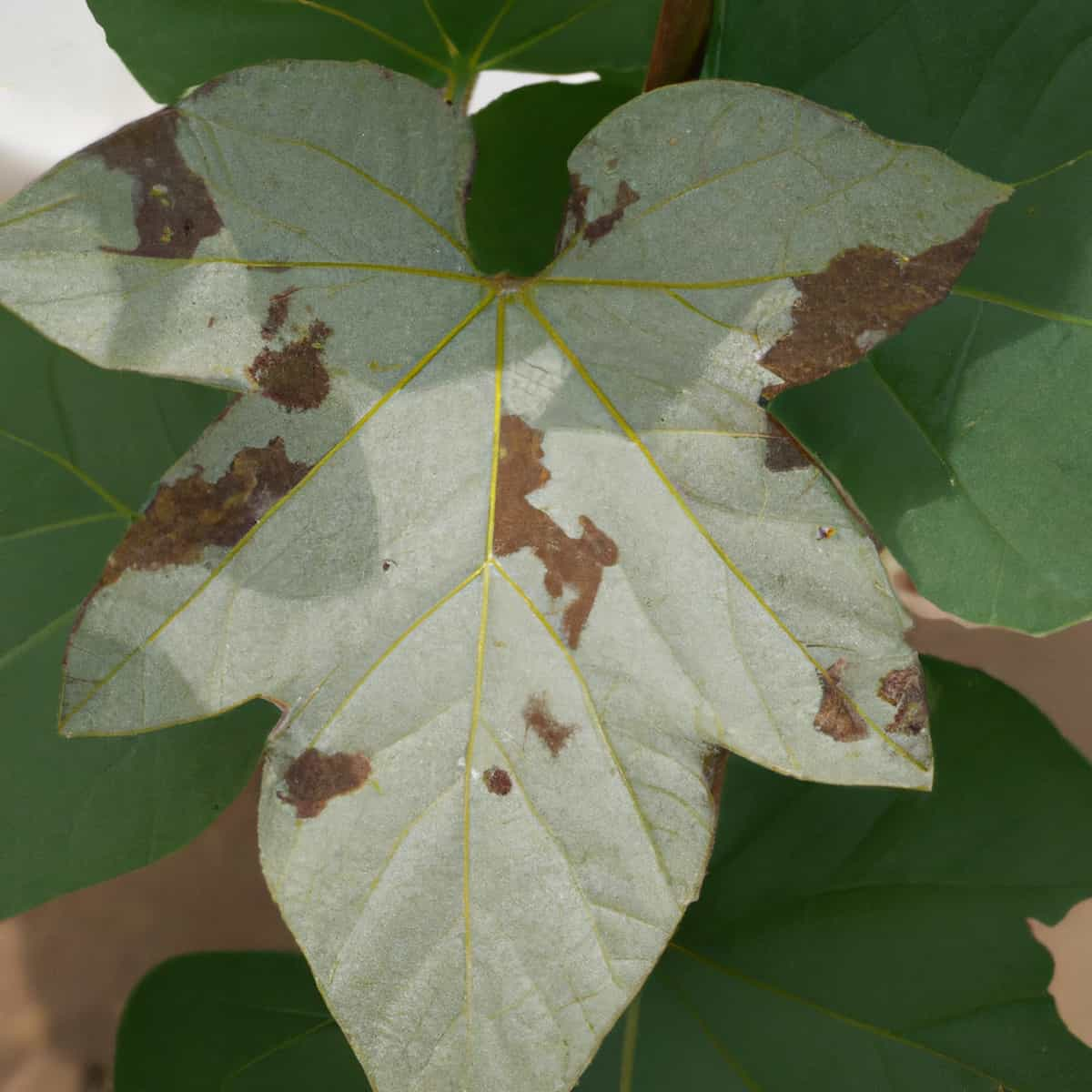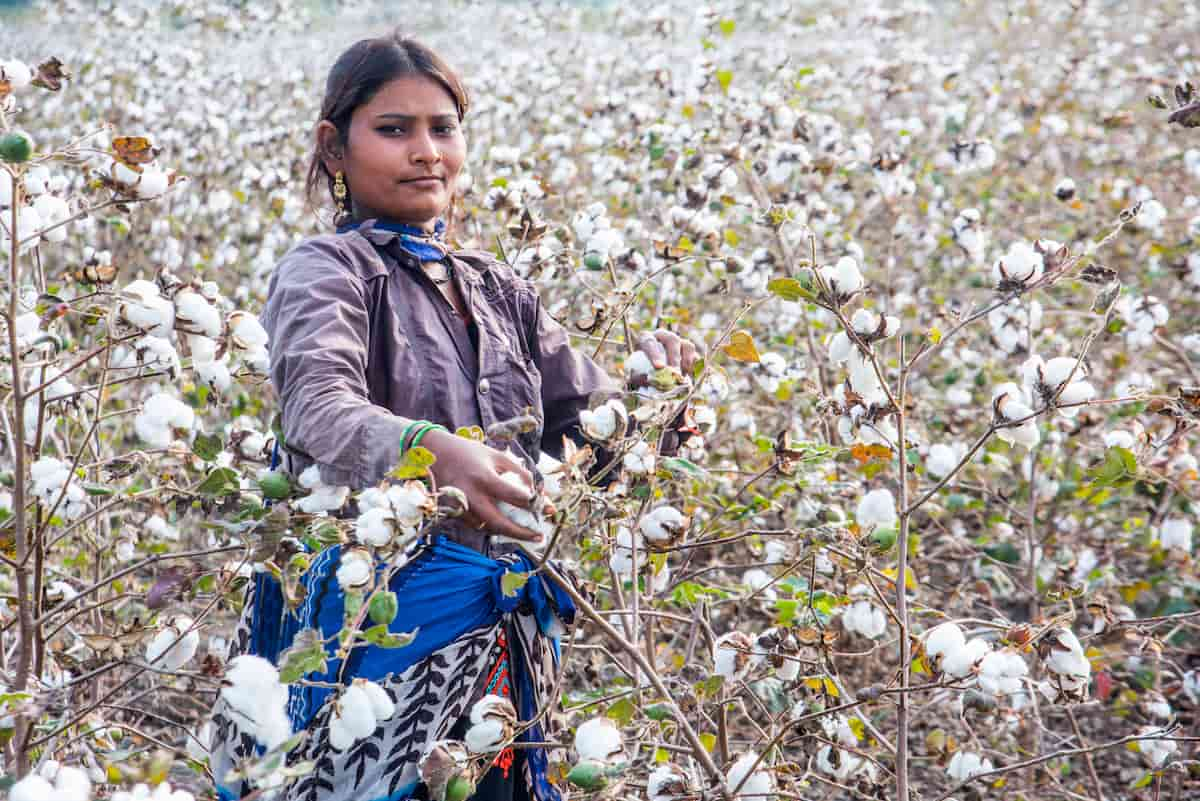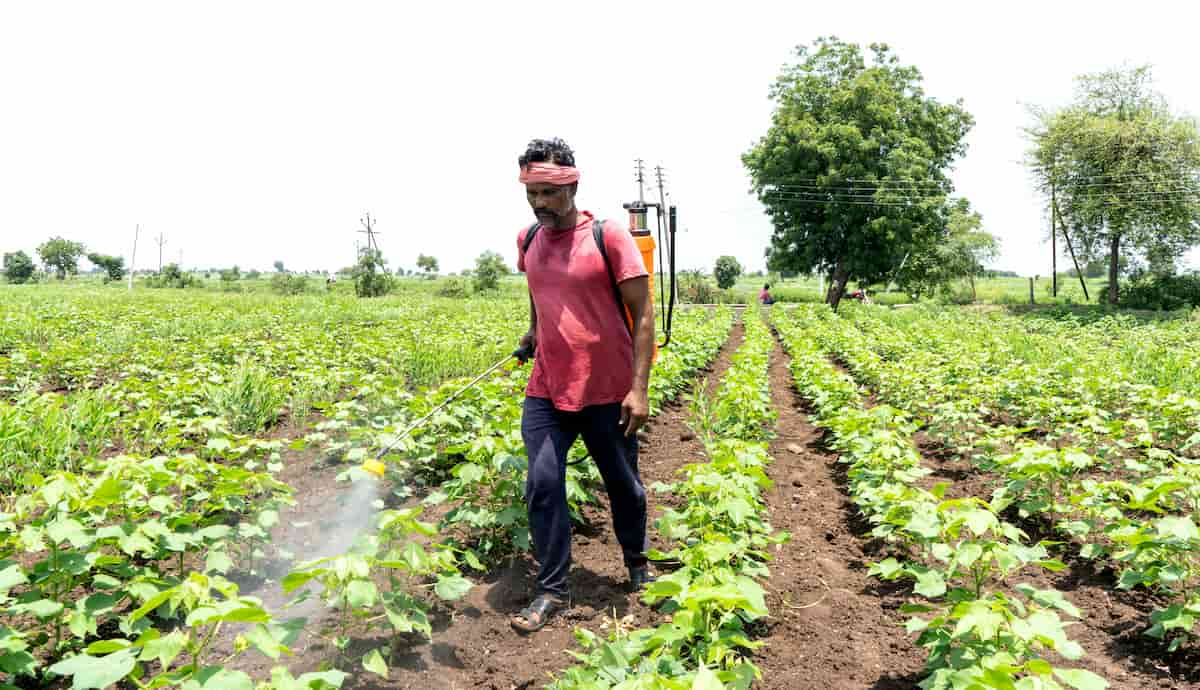The fungus Alternaria macrospora causes a disease of cotton plants known as Alternaria leaf blight (or Alternaria leaf spot). Brown or black, irregular or circular patches on the leaves define this disease, which can affect cotton at either the vegetative or floral phases of development. Leaves initially impacted by the disease will eventually die when the spots join together to form bigger regions of blight. The cotton plants’ general health and output might suffer if the disease causes the leaves to become brittle and fall off.

Alterneria Leaf Blight Management in Cotton
The Causal Organism of Alternaria Leaf Blight
Leaf blight, or Alternaria leaf spot, is a fungal disease that affects plants and is caused by the fungus Alternaria macrospora. The Alternaria genus of Ascomycetes is responsible for various plant diseases affecting vegetables, fruits, and ornamental plants. Leaf spots and defoliation are symptoms of an A. macrospora infection, which begins in the lower leaves and moves upwards through the cotton plant.
The Disease Cycle of Alternaria Leaf Blight
Alternaria leaf blight is caused by the fungi Alternaria macrospora, which may survive on cotton scraps without living tissue or an alternative host. The infection spreads by producing airborne fungal particles and splashing water onto healthy plants. It causes the illness to proceed and the formation of leaf spots. The Alternaria leaf blight disease cycle begins with the fungus infecting the cotton plant’s leaves and generating spores within the leaf spots. These pieces can then travel to healthy plants, causing the illness to spread and infect other plants.
Causes/conditions Favorable for Alternaria Leaf Blight Disease Spread in The Field.
- Alternaria leaf spot of cotton is a fungal disease that causes fast defoliation and leaf spots in cotton plants. Warm and humid climatic conditions encourage the development of this disease, with temperatures around 27°C ideal for symptom development.
- In addition to favorable weather circumstances, physiological or nutritional stress might make the cotton plant susceptible to Alternaria leaf blight. Premature 1aging or a heavy fruit load might weaken the plant, leaving it more susceptible to disease.
Symptoms of Alternaria Leaf Blight Disease
- Alternaria leaf spot disease can occur at any stage of plant growth, but it tends to be more severe when the plants are between 45 to 60 days old.
- The symptoms of the disease can be seen in the form of small, brown, irregular, or round spots on the leaves.
- Each spot is characterized by a central lesion surrounded by concentric rings.
- Multiple spots can merge to form large, blighted areas on the leaves.
- The affected leaves become brittle and eventually fall off, leading to a reduction in the overall health and productivity of the plant.
- In some cases, stem lesions may also be seen.
- In severe instances of the disease, the spots may even appear on the bracts and bolls, causing further damage to the plant.
In case you missed it: Verticillium Wilt Management in Cotton: Disease Symptoms, Treatment, Chemical, Biological, Natural, and Organic Control

Impact of Alternaria Leaf Blight Disease Management on Cotton
Wet conditions and temperatures around 27°C enhance the infection process of Alternaria leaf blight. Cotton plants are particularly susceptible to the Disease when they are seedlings and later in the season when the leaves are senescent. From the lower to upper leaves of the cotton plant, the chance of infection reduces.
Alternaria Leaf Blight Disease Management in Cotton by Cultural Method
Removing and destroying infected plant leftovers, which might serve as a primary source of infection for the fungus, is a critical step in this technique. It can help diminish the pathogen’s total population in the field, minimizing the possibility of future infections.
Crop rotation, planting disease-resistant types, and avoiding growing cotton in fields with a history of the disease are further examples of cultural techniques. Proper irrigation and fertilization control can also assist in preserving the plant’s general health, lowering the chance of infection.
Alternaria Leaf Blight Disease Management in Cotton by Biological Method
- Cotton may be biologically controlled for Alternaria leaf blight by using Pseudomonas fluorescens seed treatments.
- This bacteria has been found to protect crops by lowering the severity of the illness.
- Seed treatments with Pseudomonas fluorescens at 10g/kg be efficient in the biological control of Alternaria leaf blight disease.
Alternaria Leaf Blight Disease Management in Cotton by the Chemical Method
- A widespread disease of cotton known as Alternaria leaf blight has the potential to harm yields seriously.
- Fungicides like maneb, which comprises mancozeb, hexaconazole, tebuconazole, and difenoconazole, can be used to limit the spread of the illness even though it seldom reduces yield to the point where a particular fungicidal treatment is warranted.
- Additionally, seeds can be treated with fungicides like strobilurins or inhibitors of sterol biosynthesis like trifloxystrobin or triadimenol to render them resistant to the infection.
- At the first sign of the disease, use Mancozeb or Copper oxychloride at a rate of 2 kg/ha.
- At intervals of 15 days, two to three sprays may be applied.
In case you missed it: Root Rot Disease Management in Cotton: Symptoms, Treatment, Chemical, Biological, Natural, and Organic Control

Alternaria Leaf Blight Disease Management in Cotton by Organic/Natural Methods
Seed treatment with Pseudomonas fluorescens (10g/kg of seeds) and spraying a Pseudomonas fluorescens (0.2%) solution every ten days are organic or natural means of treating Alternaria leaf blight in cotton. These measures can help minimize disease severity and provide some crop protection. Cotton growers can reduce the impact of Alternaria leaf blight and promote healthy crop growth by combining organic or natural approaches with cultural practices.
Preventive Measures for Control of Disease Alternaria Leaf Blight
Cotton farmers can avoid the disease by planting resistant or tolerant varieties, leaving enough space between plants for better airflow. Checking for symptoms regularly, removing and burning infected plant residues away from the cotton field, avoiding plant stress, destroying severely infected plants, removing tall grasses and weeds, and rotating crops with non-host crops, like cereals.
Fall tilling also aids in disease prevention by decomposing plant debris that may harbor pathogens. These preventative measures will aid cotton growers in reducing the economic and environmental damage caused by Alternaria leaf blight.
Conclusion
Cotton Alternaria leaf blight disease may be controlled using cultural, chemical, biological, natural, and organic approaches. Crop management, including disease-resistant cultivars and a mix of fungicides and seed treatments, can help decrease the disease’s impact. An integrated strategy to disease prevention and control is required for effective treatment.
- Beneficial Insects in Pest Management
- Natural Solutions for Pest Control in Flower Gardens
- Types of Fungicides Used in Agriculture
- Common Issues in the Fruit Development Stage of Pomegranate Farming
- Fruit Development Issues in Papaya: Easy Solutions and Treatment
- Soil-Borne Diseases and How to Protect Your Plants
- Practices to Prevent Disease Spread in the Garden
- From Wilted to Thriving: How to Treat Root Rot Naturally in Houseplants
- Natural Remedies to Cure Brown Spots on Fig Tree Leaves